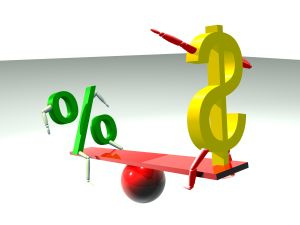Every Thursday we grab a cup o’ Joe and talk opinions on financial matters…..today we’ll chat about goal setting and workplace retirement plans.
My opinion: Do you know those 401k asset allocation charts in the front/back/middle of your workplace retirement plan booklet? They’re color coded circles of slick graphics, and are often found at the conclusion of a survey about the amount of risk you should take in your investments.
Those pie charts are nearly irrelevant when it comes to financial success.
Each day in a workplace somewhere in America you’ll find a fast-talking 401k-hocking yahoo teaching a group of people how to use these silly charts to determine how much risk they “want” to take.
How much risk you “want” to take?
“Want” and “financial success” rarely coexist when talking about money management. Most people want zero risk and huge returns. They also want Santa Claus to be a little more kind next year than last.
Is “how much risk do you want” really the question you should be asking with your 401k plan?
I have a better question.
Try this one on: How much risk do you need to take to reach your goal?
Isn’t that the question these surveys should be asking?
I know this doesn’t sound like rocket science, yet you’d think so if you’ve ever read workplace retirement plan guides. In many cases, risk tolerance charts and savings guidelines are presented as two entirely different discussions.
Huh?
Let’s be clear about what I’m discussing here. If you’re going to achieve financial success:
Find out how much you need to save.
Then learn what return you need on that savings.
If I had control of these workplace pie charts, here’s what I’d do
I’d gather everyone in the conference room and show the group how to determine the amount they need to save to reach financial success. I know that’ll differ for everyone, so it’ll be important to focus on goal calculators. With the boss’s permission, we’d follow this up with generous portions of alcohol. We’ll call it “Some of You Will Be Happy” Hour.
Second, I’d help everyone determine what return they need on that savings to achieve the retirement goal.
Sounds like I’m repeating myself, doesn’t it? I’m not.
Here’s where we finally insert the silly quiz
Third, the employees would be presented with the risk tolerance quiz. Everyone could see if the asset mix they (historically) would have needed to reach financial success matches their risk tolerance.
If so, more Happy Hour.
If it doesn’t: Houston, we have a problem.
The real problem
If you aren’t going to reach your goal, you have a choice to make: either save more money or raise your risk tolerance. One requires sweat, the other education.
Which path would you follow?
I believe that once we begin presenting 401k plans this way, instead of with some inane chart about your “risk tolerance” (lots of people very comfortably missing their goals out there), we’ll finally begin to realize that every goal can be met through a simple equation:
Savings x Return = Goal
How you approach one side will affect the other.
Okay, discussers, let’s go: Do you have a workplace retirement plan? Did it come with a silly risk tolerance chart…or did they present retirement in the brilliant manner I have above?
 (photo credits: Nutty pie chart: Sebastien Paquet, Flickr; Teeter-totter: Rambergmedialigmages, Flickr
(photo credits: Nutty pie chart: Sebastien Paquet, Flickr; Teeter-totter: Rambergmedialigmages, Flickr